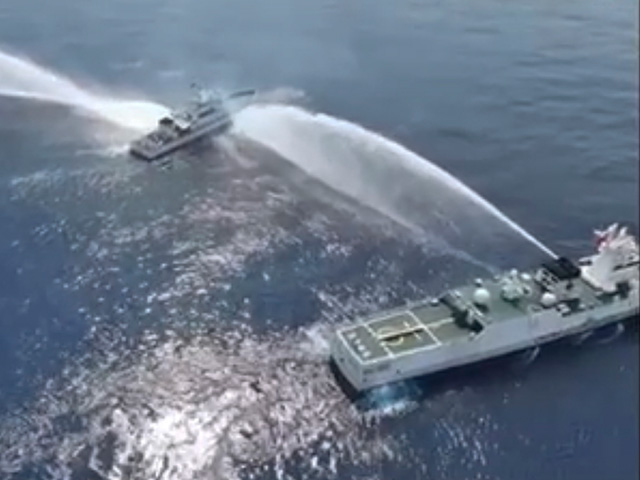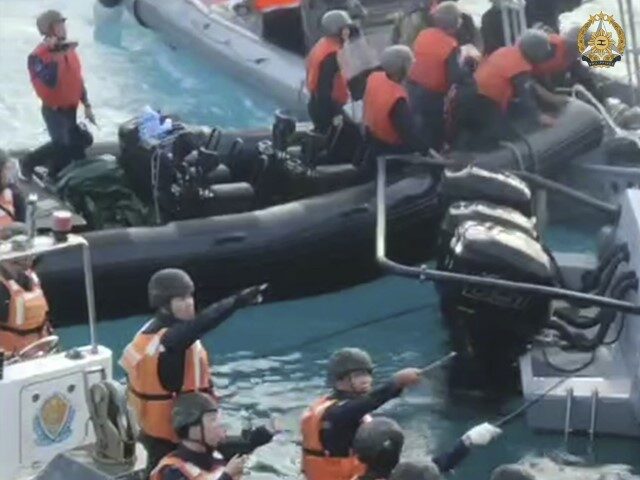The Chinese Communist regime admitted on Wednesday that it used force to board Filipino ships and force them out of the Philippines’ territorial waters, an act of piracy the Chinese touted as a “police action” because the Filipinos entered an area illegally claimed by China.
The Philippine military said its forces used their “bare hands” to fend off Chinese “barbarians” and demanded China pay damages for its conduct during the incident.
The Armed Forces of the Philippines (AFP) posted video and photos of the encounter on Wednesday night, showing Chinese personnel attacking their rigid-hulled inflatable boats (RHIBs) with knives, axes, and poles.
As with so many chapters in the growing tension between China and the Philippines, the incident on Monday occurred when the Philippine military was attempting to resupply its outpost in the Spratly Islands on the Second Thomas Shoal, which Filipinos refer to as Ayungin Shoal and China calls Ren’ai Reef.
The shoal is considered a “disputed” territory, although an international tribunal rejected China’s claim to the area in 2016. China ignored the judgment and has been trying to seize the area by force ever since.

In this image made from video provided by the Philippine Coast Guard, Philippine Coast Guard vessel, BRP BAGACAY (MRRV-4410) is water cannoned by Chinese Coast Guards as it tried to approach the waters near Scarborough Shoal, locally known as Bajo De Masinloc, at the South China Sea, on April 30, 2024. (Philippine Coast Guard via AP, File)
The Philippine military keeps a tiny complement of soldiers on a base created by deliberately running an aging ship called BRP Sierra Madre aground in 1999. Chinese vessels constantly interfere with Philippine efforts to supply the outpost and rotate its personnel. China’s interference has grown increasingly aggressive, with tactics including unsafe maneuvers, collisions, and blasting Philippine ships with water cannons.
The Philippine military said things came to a head on Monday when the Chinese Coast Guard (CCG) rammed Philippine supply ships and boarded them with swords and knives. The Chinese ships were much larger than the three Filipino craft, which included two RHIBs and a small civilian ship contracted by the military to carry supplies.
The Filipinos fought back bare-handed, resulting in several injuries. One Filipino soldier reportedly lost a thumb when one of the Chinese steel-hulled ships rammed the inflatable boat he was riding in.
Gen. Romeo Brawner, chief of the Armed Forces of the Philippines (AFP), described China’s actions as “piracy” on Wednesday and demanded China pay for damages to the Philippine craft, as well as returning some disassembled rifles they confiscated. The rifles were supposed to be delivered to the troops stationed on the Sierra Madre.
Brawner described the one-sided battle as a mixed group of eight Chinese steel-hulled vessels and RHIBs swarming the Filipino craft, and the Chinese then using bladed weapons to puncture their inflatable hulls.
“We cannot let them just do this and take our [assets]. For me, this is piracy because they boarded [our vessel] illegally, they got our equipment. Again, they acted like pirates,” Brawner said, as translated by Philippine news site Rappler. Like many Filipino officials, Brawner mixed Filipino and English when he spoke.
Gen. Brawner noted that Filipino forces are not allowed to carry firearms in the Spratly Islands region, to avoid escalating tensions. This is also why supply missions to the Second Thomas Shoal are carried out by RHIBs and civilian ships instead of Philippine Navy vessels. Brawner pointed out that Chinese forces are supposed to follow similar de-escalation protocols.
“The Chinese Coast Guard personnel had bladed weapons, and our personnel fought with bare hands. That is what’s important. We were outnumbered and their weapons were unexpected, but our personnel fought back with everything they had,” he said.
“I want to eliminate impressions that our soldiers just let the CCG have their way, and let the CCG take our things and destroy our boats,” he said, commending his forces for fighting back bravely, “despite the limitations.”
“I admire the Filipino soldier because of the restraint they practiced. Our objective is also to prevent war,” he said.
Brawner proceeded to bestow a Wounded Personnel Medal upon Seaman First class Underwater Operator Jefferson Facundo, the man who lost his thumb.
In a statement posted to the AFP’s Facebook account, Brawner said the Chinese Coast Guard “has no right or legal authority to interfere with our legitimate operations or damage our assets within our Exclusive Economic Zone.”
“This reckless and aggressive behavior has caused bodily harm, and constitutes a blatant violation of international maritime law, Philippine sovereignty, and sovereign rights,” he said.
Philippine Coast Guard Commodore Jay Tarriela called the Chinese Coast Guard “barbaric” for blatantly using “physical attacks and violence” to obstruct a legitimate humanitarian supply mission.
“These provocative, unprofessional, and inhumane actions of China, if left unchecked, will not just be a loss for our fight in the West Philippine Sea. They serve as a clear indication that humanity has once again allowed barbarism to trample upon compassion, and that what is right is only defined by might,” he said.
Tarriela accused China of trying to goad the United States, which has a defense pact with the Philippines, into an intemperate response to “justify their false narrative that Washington really wants to go to war with Beijing.”
The United States, Canada, and Japan also condemned China’s actions. U.S. Ambassador to the Philippines MaryKay Carson called them “aggressive, dangerous maneuvers” which “caused bodily injury, damaged Philippine vessels, and hindered lawful maritime operations.”
Carson pointed out that China used force to interfere with the Philippines delivering “food, water, and essential supplies” to Filipino troops operating within their own exclusive economic zone.
Japanese Ambassador to the Philippines Endo Kazuya expressed his government’s “grave concern over the repeated dangerous and aggressive actions by the CCG, which put Philippine personnel at risk and damaged Philippine boats.”
“We stand with the Philippines and cooperate with like-minded countries in maintaining and enhancing the free and open international order based on the rule of law,” Endo said.
Canadian Ambassador to the Philippines David Hartman condemned the “dangerous and destabilizing actions” taken by China, calling them “inconsistent with the People’s Republic of China’s obligations under international law, including the U.N. Convention on the Law of the Sea (UNCLOS).”
“Furthermore, reports of boarding and towing of Philippine vessels by the PRC are deeply concerning. These actions jeopardize regional peace, stability and prosperity throughout the Indo-Pacific,” Hartman said.
China’s state-run Global Times on Wednesday insisted, despite all evidence to the contrary, that the Chinese Coast Guard acted with professionalism and restraint when it conducted the “interception, boarding, inspection, and expelling of Philippine vessels.”
“The CCG’s law enforcement measures aimed at intercepting illegal Philippine supplies and did not feature direct measures against Philippine personnel,” the Global Times insisted, an assertion that Seaman First class Underwater Operator Jefferson Facundo would strongly disagree with.
The Global Times falsely accused the Filipinos of intruding into Chinese waters and making “dangerous maneuvers that threatened the safety of both sides.” Chinese officials also falsely declared the presence of the grounded Sierra Madre on the Second Thomas Shoal to be “illegal,” so anything the Filipinos do to resupply their base would be a crime, and anything Chinese forces do to stop them is justifiable “law enforcement.”
The Global Times even bizarrely accused the Philippines of using “gray zone tactics,” which is in fact China’s preferred method for wearing down its enemies until they submit to Beijing’s demands.
Gray zone warfare involves taking provocative actions that exhaust smaller military forces by obliging them to respond and monitor China’s antics, as in the case of Taiwan, which must perpetually launch ships and planes to keep an eye on Chinese forces that penetrate their Air Defense Identification Zone (ADIZ).
Gray zone maneuvers are a bullying tactic that only works if the target is much smaller than the aggressor, so the idea that the Philippines could “exhaust” China by sailing a few supply boats into the teeth of a Chinese force that outnumbers them by six-to-one is absurd.
For good measure, the Global Times accused Philippine President Ferdinand Marcos, Jr., of provoking trouble with China to distract from his “economic, standard of living, and social problems.”

COMMENTS
Please let us know if you're having issues with commenting.